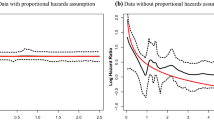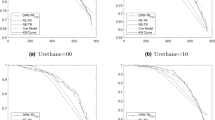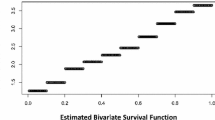Abstract
Competing risks data are routinely encountered in various medical applications due to the fact that patients may die from different causes. Recently, several models have been proposed for fitting such survival data. In this paper, we develop a fully specified subdistribution model for survival data in the presence of competing risks via a subdistribution model for the primary cause of death and conditional distributions for other causes of death. Various properties of this fully specified subdistribution model have been examined. An efficient Gibbs sampling algorithm via latent variables is developed to carry out posterior computations. Deviance information criterion (DIC) and logarithm of the pseudomarginal likelihood (LPML) are used for model comparison. An extensive simulation study is carried out to examine the performance of DIC and LPML in comparing the cause-specific hazards model, the mixture model, and the fully specified subdistribution model. The proposed methodology is applied to analyze a real dataset from a prostate cancer study in detail.
Similar content being viewed by others
References
Chen MH, Ibrahim JG, Shao QM (2006) Posterior propriety and computation for the Cox regression model with applications to missing covariates. Biometrika 93: 791–807
Chen MH, Shao QM (1999) Monte Carlo estimation of Bayesian credible and HPD intervals. J Comput Graph Stat 8: 69–92
Chen MH, Shao QM, Ibrahim JG (2000) Monte Carlo methods in Bayesian computation. Springer, New York
Choueiri TK, Chen MH, D’Amico AV, Sun L, Nguyen PL, Hayes JH, Robertson CN, Walther PJ, Polascik TJ, Albala DM, Moul JW (2010) Impact of postoperative prostate-specific antigen disease recurrence and the use of salvage therapy on the risk of death. Cancer 116: 1887–1892
Clayton DG (1978) A model for association in bivariate life tables and its application in epidemiological studies of familial tendency in chronic disease incidence. Biometrika 65: 141–151
Cox DR (1972) Regression models and life tables (with discussion). J R Stat Soc B 34: 187–220
Cox DR (1975) Partial likelihood. Biometrika 62: 269–276
Dixon SN, Darlington GA, Desmond AF (2011) A competing risks model for correlated data based on the subdistribution hazard. Lifetime Data Anal 17: 473–495
Elashoff RM, Li G, Li N (2007) An approach to joint analysis of longitudinal measurements and competing risks failure time data. Stat Med 26: 2813–2835
Elashoff RM, Li G, Li N (2008) A joint model for longitudinal measurements and survival data in the presence of multiple failure types. Biometrics 64: 762–771
Fan X (2008) Bayesian nonparametric inference for competing risks data. Unpublished Ph.D. Dissertation, Division of Biostatistics, Medical College of Wisconsin
Fine JP, Gray RJ (1999) A proportional hazards model for the subdistribution of a competing risk. J Am Stat Assoc 94: 496–509
Gail M (1975) A review and critique on some models used in competing risk analysis. Biometrics 31: 209–222
Gaynor JJ, Feuer EJ, Tan CC, Wu DH, Little CR, Strauss DJ, Clarkson BD, Brennan MF (1993) On the use of cause-specific failure and conditional failure probabilities: examples from clinical oncology data. J Am Stat Assoc 88: 400–409
Gelfand AE, Dey DK (1994) Bayesian model choice: asymptotics and exact calculations. J R Stat Soc B 56: 501–514
Gilks WR, Wild P (1992) Adaptive rejection sampling for Gibbs sampling. Appl Stat 41: 337–348
Gray RJ (1988) A class of K-sample tests for comparing the cumulative incidence of a competing risk. Ann Stat 16: 1141–1154
Hu W, Li G, Li N (2009) A Bayesian approach to joint analysis of longitudinal measurements and competing risks failure time data. Stat Med 28: 1601–1619
Huang X, Li G, Elashoff RM, Pan J (2011) A general joint model for longitudinal measurements and competing risks survival data with heterogeneous random effects. Lifetime Data Anal 17: 80–100
Ibrahim JG, Chen MH, Sinha D (2001) Bayesian survival analysis. Springer, New York
Kalbfleisch JD (1978) Non-parametric Bayesian analysis of survival time data. J R Stat Soc B 40: 214–221
Larson MG, Dinse GE (1985) A mixture model for the regression analysis of competing risks data. Appl Stat 34: 201–211
Liu JS (1994) The collapsed Gibbs sampler in Bayesian computations with applications to a gene regulation problem. J Am Stat Assoc 89: 958–966
Lu K, Tsiatis AA (2001) Multiple imputation methods for estimating regression coefficients in the competing risks model with missing cause of failure. Biometrics 57: 1191–1197
Prentice RL, Kalbfleisch JD, Peterson A, Flournoy N, Farewell V, Breslow N (1978) The analysis of failure times in the presence of competing risks. Biometrics 34: 541–554
Sinha D, Ibrahim JG, Chen MH (2003) A Bayesian justification of Cox’s partial likelihood. Biometrika 90: 629–641
Spiegelhalter DJ, Best NG, Carlin BP, van der Linde A (2002) Bayesian measures of model complexity and fit (with Discussion). J R Stat Soc B 64: 583–639
Tsiatis A (1975) A nonidentifiability aspect of the problem of competing risks. Proc Natl Acad Sci USA 72: 20–22
Vaupel JW, Manton KG, Stallard E (1979) The impact of heterogeneity in individual frailty on the dynamics of mortality. Demography 16: 439–454
Wang X, Sinha A, Yang J, Chen MH (2012) Bayesian inference of interval-censored survival data. In: Chen DG, Sun J, Peace KE (eds) Interval-censored time-toevent data: methods and applications. Chapman & Hall, Boca Raton, FL (in press)
Author information
Authors and Affiliations
Corresponding author
Rights and permissions
About this article
Cite this article
Ge, M., Chen, MH. Bayesian inference of the fully specified subdistribution model for survival data with competing risks. Lifetime Data Anal 18, 339–363 (2012). https://doi.org/10.1007/s10985-012-9221-9
Received:
Accepted:
Published:
Issue Date:
DOI: https://doi.org/10.1007/s10985-012-9221-9




